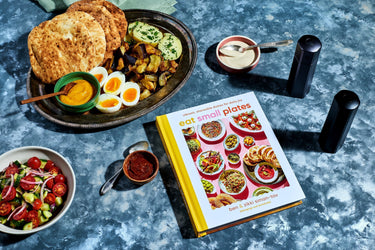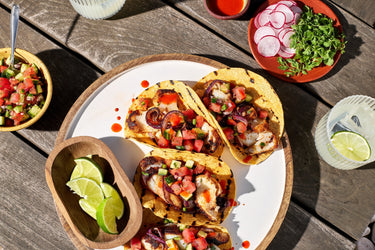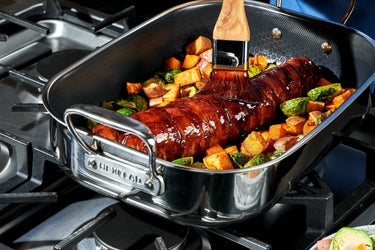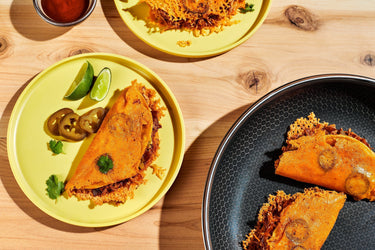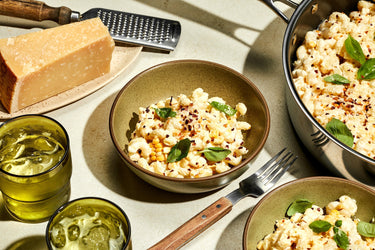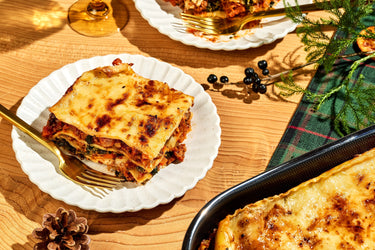10 Key Chemical Reactions in Cooking
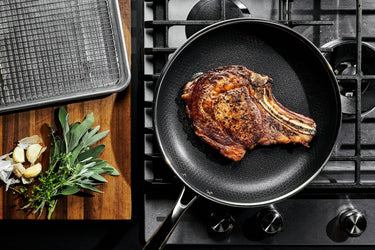
Food is not solely a craft and an art; it’s also a science. While we may not have the periodic table running through our brain as we whisk an egg to fluffy perfection, the cooking methods that make food taste so darn good are due to chemical reactions.
At its core, cooking food is a series of transformations. Raw ingredients undergo chemical processes that change their textures, flavors and nutritional profiles. Understanding these reactions–and having the right tools to support them–can help you feel more comfortable experimenting in the kitchen. But don’t break a sweat: Replace those mental images of beakers and Bunsen burners from chemistry class with those of your trusted stovetop and HexClad pans.
Today, we’re diving deep into the science of cooking, focusing on the top 10 chemical reactions that elevate the art of food preparation
What Are Some of the Most Common Chemical Reactions in the Kitchen?
When it comes to food science, 10 key chemical reactions play a vital role in almost every dish you create. From the bubbles in your dough to the crispy brown crust of a steak, chemical reactions are what bring food to life.
1. Fermentation
Humans have benefited from fermentation for thousands of years. We’ve been fermenting food long before we even knew what the process was. In fact, many of the most beloved foods and beverages in the world are the products of fermentation.
Fermentation is the process in which carbohydrates break down into simpler molecules without oxygen–a process known as anaerobic respiration. This is a biological reaction facilitated by microorganisms like bacteria, yeast and molds. These organisms metabolize sugars to produce gases like carbon dioxide, alcohol or acids, transforming the food's structure and flavor.
Fermentation doesn’t need heat to occur, but the temperature can influence the speed and outcome. Some of our favorite food and drinks, such as beer, wine, yogurt, kombucha and sauerkraut, are all results of fermentation. Sourdough bread, with its tangy flavor, is a perfect example of how this reaction changes the food's texture and taste, thanks to the microbes working overtime.
2. The Maillard Reaction
Discovered by biochemist Louis-Camille Maillard in 1912, the Maillard reaction is one of the most important chemical reactions in cooking. It’s responsible for the rich, golden-brown crust on a perfectly seared steak or the deliciously toasted outer layer of a baguette.
At its core, the Maillard reaction occurs when amino acids (from proteins) interact with reducing sugars under high heat. Unlike caramelization, which involves just sugars, the Maillard reaction produces a complex mix of new flavors, aromas, and color. This chemical change also contributes to the savory umami taste we associate with roasted meats and grilled vegetables.
To achieve the best Maillard browning, the right tools matter. In a nonstick and heat-retaining pan such as the Hexclad skillet or wok, the Maillard reaction can also transform the chemical structure of the surface of the foods, adding delectable crisp and complex flavor notes. The result? That perfect, crispy texture with rich, deep flavors we all love so much.
3. Caramelization
Similar to the Maillard reaction, caramelization involves heating sugar molecules until they break down into new compounds that produce a golden-brown color, rich flavors and an irresistible aroma. However, while the Maillard reaction also involves proteins, caramelization is purely about sugar.
This chemical process is essential for many dishes, from caramelized onions–where slow cooking brings out a sweet, savory flavor–to the golden crust on a crème brûlée. Foods such as onions, apples and bananas, which contain natural sugars, are also excellent candidates for caramelization. The key to perfect caramelization is patience: Heat the sugar slowly to bring out its complex flavors and avoid burning it.
4. Gluten Formation
Gluten is the sticky, elastic protein network that forms when two specific proteins–glutenin and gliadin–are mixed with water. Found primarily in wheat, gluten is essential in many baked goods. It’s what gives bread its chewy texture and helps pasta hold its shape.
When you knead dough, you’re encouraging these proteins to bond and form a strong gluten network. In bread-making, this network traps carbon dioxide produced by yeast during fermentation, causing the dough to rise. The more you knead, the more gluten develops, leading to a firmer, chewier texture. Pro tip: This is why kneading is so important for bread but not for cakes, where you want a more delicate crumb.
5. Pyrolysis
Pyrolysis is a fascinating chemical reaction that happens when a substance breaks down due to extreme heat in the absence of oxygen. You’ve likely seen this reaction in action when searing meat in a hot pan. Pyrolysis leads to the formation of a crisp, flavorful outer crust on food, but timing is key, because too much heat can lead to over-charring.
Pyrolysis is also crucial when seasoning cookware, particularly cast iron. When you heat oil past its smoking point, it carbonizes, creating a layer that protects the surface and helps food cook more evenly. This process forms a natural nonstick surface and adds flavor to your dishes over time.
Having the right pan when working with a stovetop is vital to help keep your food from burning. A HexClad Hybrid skillet can help you achieve the perfect sear and crisp without losing any of your meal to the bottom of the pan, where it could otherwise stick and burn beyond repair.
6. Acid-Base Reactions
Acids are everywhere in the kitchen. From lemons and tomatoes to vinegar and wine, acids add tartness and can even alter the structure of foods. When used in marinades, for instance, acidic ingredients help break down tough or sinewy proteins, tenderizing meat and infusing it with flavor.
On the flip side, bases (or alkaline substances) play an essential role in neutralizing acids. Baking powder, for example, is a base that interacts with acidic ingredients like buttermilk to release carbon dioxide, causing dough or batter to rise. Eggs also contain proteins that can interact with acids to create emulsions, like when you’re whipping up a classic Hollandaise sauce.
7. Protein Denaturation
Proteins are large, complex molecules that can take on various shapes and structures. When they’re exposed to heat or acid, their bonds break, and they "unravel" in a process known as denaturation. This is the reason why eggs turn from clear to opaque when cooked, and why the texture of meat changes when it’s grilled.
Denaturation plays an essential role in many culinary techniques. For instance, whipping egg whites causes the proteins to denature and form a foam, which is crucial in creating meringues or soufflés. The process also makes it easier for proteins to bind with other ingredients, improving the consistency and texture of batters.
8. Emulsification
Emulsification is the process by which two immiscible liquids (translation: oil and water) are forced to combine into a stable mixture. This is where emulsifying agents such as egg yolks, mustard or honey come into play.
Egg yolks are the powerhouse emulsifiers in recipes like mayonnaise and hollandaise sauce, in which they help oil and water blend into a velvety consistency. Similarly, the natural emulsifiers in mustard allow it to stabilize vinaigrettes and salad dressings. Emulsification is essential in creating smooth textures and preventing separation.
9. Carbonization
Carbonization is a chemical reaction that occurs when complex carbon-based substances are exposed to heat and break down into elemental carbon and chemical compounds. This is a process that will come in handy when it comes to caring for your cast-iron or Hybrid cookware.
So, carbonization can reduce the risk of foods getting stuck on the pan, as this is a main part of the seasoning process. When we season our pans, we need to apply a thin coat of unsaturated oil applied to the pan and heat it past the oil’s smoking point. This carbonizes the oil, making it harder to remove.
As the carbonized oil builds within your pan, it will add flavor to your dishes and form a barrier to keep food molecules from binding with the iron, forming that beloved nonstick surface. (For more information on how to season and care for your HexClad Hybrid pans, head right here.)
10. Combustion
Combustion is the rapid chemical reaction between a substance and oxygen that produces heat and light. In the kitchen, combustion powers gas stoves, giving chefs precise control over their heat. It’s also the reaction behind flambé, in which alcohol is ignited to create a brief burst of flame. Setting certain foods ablaze this way can add a rich caramelized flavor as the alcohol cooks off.
Combustion is also essential for grilling, in which the heat from the flames interacts with meat, vegetables and other foods, creating smoky flavors and complex textures.
Become a Pro in the Kitchen With the Right Tools
Understanding the world of food chemistry can drastically improve both your technique and the final results (read: more delicious dinners). At Hexclad, we design our cookware to work hand-in-hand (or pan-in-pan) with these key chemical reactions for a more enjoyable cooking experience and a delicious end result.
Whisk up a mean emulsifier in our sleek and lightweight Mixing Bowls, let protein denaturation and acid-base reactions create fluffy eggs and pancakes on our 12-inch Griddle Pan, and put Maillard browning into action with our patented Hybrid technology to create the perfect sear–stick-free.
Ready to become a food chemist whiz in the kitchen with Hexclad? You can check out all of HexClad’s forward-thinking cookware at our online store today.

